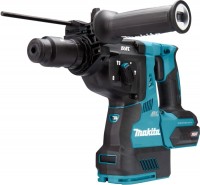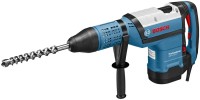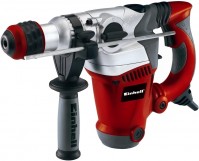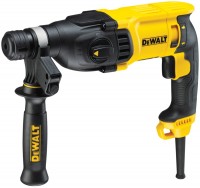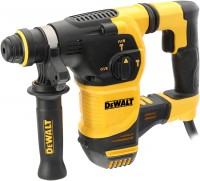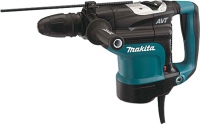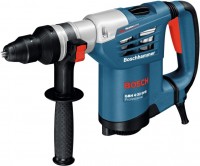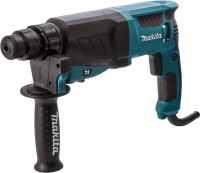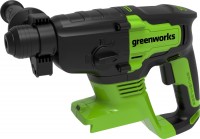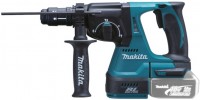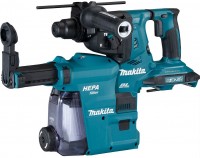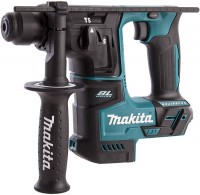Rotary Hammers DeWALT
All Rotary Hammers Advanced filters → |
You might be interested in
Articles, reviews, useful tips
All materials
Screwdriver that can drill concrete: myth or reality
What does it take to drill a hole in the wall with a screwdriver? Which model should I choose for drilling concrete?

One battery for the whole tool: multi-platform battery series
The concept of using a universal battery for cordless tools is gaining momentum

Drill chuck: types and differences
Specifics of different types of chucks for drilling and working with fasteners

What is the best screwdriver?
Among thousands of screwdrivers, you can find one that surpasses the rest in all respects. Or is it impossible?

Screwdrivers and drills for dummies
Questions about drills and screwdrivers that beginners are embarrassed to ask more experienced craftsmen

Five great cordless jigsaws for the home workshop
Cordless tools for sawing boards, cutting sheet lumber and cutting thin metal workpieces
Rotary Hammers: specifications, types
Show all
Operating modes
— Drilling with impact. A mode of operation that combines rotation and percussive movement of the drill. Due to this, a complex effect on the treated surface is provided; in this case, the impact gives a direct advancement of the drill, and rotation is used primarily to remove the resulting waste. It is this format of work that allows you to effectively make holes in materials like concrete, brick, natural stone, etc .; at the same time, rotary hammers cope with such tasks much more efficiently than the so-called impact drills (drills supplemented with a chiseling function).
— Drilling (without impact). Traditional drilling, when the hammer works like a drill: the working equipment only rotates, not moving back and forth. It is applied to work with rather soft materials, such as a tree and metal. At the same time, rotary hammers are often more efficient than traditional drills — due to the greater power and weight of the tool, they allow you to drill larger and deeper holes with sufficient accuracy.
— Chiseling (demolition hammer). In this mode, the punch tool only moves back and forth, without rotation. This format of work can be useful when splitting large pieces of hard material, removing various coatings, etc. We emphasize that a rotary hammer, even a powerful and heavy one, will not replace a full-fledged demolition hammer; however, for relatively simple tasks — such as dismantling smal...l structures made of relatively soft materials, splitting tiles, chasing walls, etc. — a tool with this mode is quite suitable.
— Drilling (without impact). Traditional drilling, when the hammer works like a drill: the working equipment only rotates, not moving back and forth. It is applied to work with rather soft materials, such as a tree and metal. At the same time, rotary hammers are often more efficient than traditional drills — due to the greater power and weight of the tool, they allow you to drill larger and deeper holes with sufficient accuracy.
— Chiseling (demolition hammer). In this mode, the punch tool only moves back and forth, without rotation. This format of work can be useful when splitting large pieces of hard material, removing various coatings, etc. We emphasize that a rotary hammer, even a powerful and heavy one, will not replace a full-fledged demolition hammer; however, for relatively simple tasks — such as dismantling smal...l structures made of relatively soft materials, splitting tiles, chasing walls, etc. — a tool with this mode is quite suitable.
Real power
The power given out by the perforator directly to the drill or other working equipment. This figure is inevitably lower than the power consumption (see below) due to energy losses in the tool mechanisms.
In general, higher net power means more efficiency and productivity; the reverse side of these advantages is an increase in price, energy consumption, dimensions and weight (however, the latter is not always a drawback for rotary hammers). In addition, note that tools with similar useful power values may differ in the ratio of chiseling speed and impact power: remember, a higher frequency means less energy for each individual impact, and vice versa. So the big numbers in this paragraph can mean both high efficiency when working with hard, stubborn materials, and good performance on relatively simple tasks; these features need to be specified separately.
Also, by the ratio of useful and consumed power, one can evaluate the efficiency of the tool in terms of energy consumption: the lower the power consumption (with the same useful power), the more efficient this model is. The downside of energy efficiency is often increased cost, but it can be recouped fairly quickly in energy savings, especially if you work long hours and often.
In general, higher net power means more efficiency and productivity; the reverse side of these advantages is an increase in price, energy consumption, dimensions and weight (however, the latter is not always a drawback for rotary hammers). In addition, note that tools with similar useful power values may differ in the ratio of chiseling speed and impact power: remember, a higher frequency means less energy for each individual impact, and vice versa. So the big numbers in this paragraph can mean both high efficiency when working with hard, stubborn materials, and good performance on relatively simple tasks; these features need to be specified separately.
Also, by the ratio of useful and consumed power, one can evaluate the efficiency of the tool in terms of energy consumption: the lower the power consumption (with the same useful power), the more efficient this model is. The downside of energy efficiency is often increased cost, but it can be recouped fairly quickly in energy savings, especially if you work long hours and often.
Power consumption
Rated power consumed by the rotary hammer during operation. Usually, the maximum power consumption in normal operation is taken as the nominal power.
In general, the higher this indicator, the heavier and more performant the rotary hammer is, the more advanced its performance usually turns out to be. On the other hand, the electricity consumption of such tools is high. In addition, note that with the same power consumption, the actual set of individual characteristics for different tools may be different. For example, frequency and impact energy are inversely related, and for the same power input, higher frequency usually means less individual impact energy. So, according to this parameter, it is worth evaluating only the overall level of the instrument; for accurate selection for specific tasks, you need to pay attention to more specific characteristics.
Also note that power consumption data can be useful for some tasks related to catering — for example, if a construction site is powered by an autonomous generator and you need to estimate the load on this energy source.
In general, the higher this indicator, the heavier and more performant the rotary hammer is, the more advanced its performance usually turns out to be. On the other hand, the electricity consumption of such tools is high. In addition, note that with the same power consumption, the actual set of individual characteristics for different tools may be different. For example, frequency and impact energy are inversely related, and for the same power input, higher frequency usually means less individual impact energy. So, according to this parameter, it is worth evaluating only the overall level of the instrument; for accurate selection for specific tasks, you need to pay attention to more specific characteristics.
Also note that power consumption data can be useful for some tasks related to catering — for example, if a construction site is powered by an autonomous generator and you need to estimate the load on this energy source.
Impact energy
The energy transmitted by the perforator to the material being processed upon impact; the higher this indicator, the stronger and more powerful each individual blow.
First of all, we recall that the energy of impacts is directly related to their frequency: an increase in frequency leads to a decrease in energy. Therefore, for models where the number of strokes can be adjusted, this paragraph usually gives the maximum energy achieved at the minimum speed of operation.
In general, higher impact energy improves efficiency when working with hard, stubborn materials, but requires more motor power (especially if it has to be combined with a high frequency). Therefore, it is worth choosing according to this parameter, taking into account specific tasks. So, for occasional use in everyday life, an energy of 2 J or less is enough, for home repair work of medium intensity, at least 3 J is desirable; a power of 4 J or more is already considered high; and in some industrial-grade perforators, this figure can reach 30 J.
First of all, we recall that the energy of impacts is directly related to their frequency: an increase in frequency leads to a decrease in energy. Therefore, for models where the number of strokes can be adjusted, this paragraph usually gives the maximum energy achieved at the minimum speed of operation.
In general, higher impact energy improves efficiency when working with hard, stubborn materials, but requires more motor power (especially if it has to be combined with a high frequency). Therefore, it is worth choosing according to this parameter, taking into account specific tasks. So, for occasional use in everyday life, an energy of 2 J or less is enough, for home repair work of medium intensity, at least 3 J is desirable; a power of 4 J or more is already considered high; and in some industrial-grade perforators, this figure can reach 30 J.
Number of thrusts
The number of beats per minute provided by the punch. For models in which the beat frequency can be adjusted, this item indicates the entire adjustment range, for example "1600 — 3000".
High impact frequency, on the one hand, increases the productivity of the tool and can significantly reduce the time required for work. On the other hand, with the same engine power, an increase in the number of strokes per minute leads to a decrease in the energy of each stroke. Therefore, among heavy performant devices, a low frequency is often found — up to 2500 beats / min and even lower. And the ability to adjust the frequency of impacts allows you to adjust the hammer to the specific situation, depending on what is more important — productivity or the ability to cope with hard, stubborn material. For example, for old crumbling brickwork, you can set the speed higher, and for working with stone or dense concrete, it is better to reduce the frequency of impacts by directing engine power to increase the energy of each impact.
Summing up, we can say this: when choosing a perforator, you should focus on both the number of strokes and the impact energy. Detailed recommendations on this subject for specific situations can be found in special sources.
High impact frequency, on the one hand, increases the productivity of the tool and can significantly reduce the time required for work. On the other hand, with the same engine power, an increase in the number of strokes per minute leads to a decrease in the energy of each stroke. Therefore, among heavy performant devices, a low frequency is often found — up to 2500 beats / min and even lower. And the ability to adjust the frequency of impacts allows you to adjust the hammer to the specific situation, depending on what is more important — productivity or the ability to cope with hard, stubborn material. For example, for old crumbling brickwork, you can set the speed higher, and for working with stone or dense concrete, it is better to reduce the frequency of impacts by directing engine power to increase the energy of each impact.
Summing up, we can say this: when choosing a perforator, you should focus on both the number of strokes and the impact energy. Detailed recommendations on this subject for specific situations can be found in special sources.
Rotation speed
The speed of rotation of the working equipment provided by the rotary hammer. Usually, this indicates the speed at idle, without load; rated load speeds can be further specified in the characteristics (see below), but this is rare, and this parameter is still considered the main characteristic. It is also worth mentioning that in the presence of a speed controller (see "Functions"), the maximum speed value is given here.
When working in the main mode — drilling with impact — the rotation of the equipment is used mainly to remove waste from the hole, and the revolutions here are of no fundamental importance (they can be very low). Therefore, it is worth paying attention to this indicator mainly in cases where the rotary hammer is planned to be often used for conventional drilling, without impact. And here it is worth proceeding from the fact that high speeds increase productivity and contribute to accuracy when working with some materials, but reduce torque (compared to tools with the same engine power). So for heavy work with hard, stubborn materials, relatively "slow" tools are usually better suited.
Note also that drilling is not the main task of rotary hammers; therefore, their rotation speeds are noticeably lower than those of the same drills. On the other hand, in this case, low speeds are often compensated by powerful engines and high torque, which makes it possible to effectively drill holes...of a fairly large diameter, including using crowns.
When working in the main mode — drilling with impact — the rotation of the equipment is used mainly to remove waste from the hole, and the revolutions here are of no fundamental importance (they can be very low). Therefore, it is worth paying attention to this indicator mainly in cases where the rotary hammer is planned to be often used for conventional drilling, without impact. And here it is worth proceeding from the fact that high speeds increase productivity and contribute to accuracy when working with some materials, but reduce torque (compared to tools with the same engine power). So for heavy work with hard, stubborn materials, relatively "slow" tools are usually better suited.
Note also that drilling is not the main task of rotary hammers; therefore, their rotation speeds are noticeably lower than those of the same drills. On the other hand, in this case, low speeds are often compensated by powerful engines and high torque, which makes it possible to effectively drill holes...of a fairly large diameter, including using crowns.
Rated load speed
The revolutions developed by the rotary hammer motor at the rated load on the tool.
Rated is usually considered the greatest load that the tool is able to transfer without breakage for a sufficiently long operation. Anyway, this parameter is indicated relatively rarely, since idle speed is traditionally considered the main characteristic (see "Number of revolutions" above). However, load speed data also allows you to evaluate some of the features of the rock drill. So, higher rated load speeds (at the same idle speed) in fact means at least higher productivity, and in many cases also the ability to cope with complex tasks more efficiently.
Rated is usually considered the greatest load that the tool is able to transfer without breakage for a sufficiently long operation. Anyway, this parameter is indicated relatively rarely, since idle speed is traditionally considered the main characteristic (see "Number of revolutions" above). However, load speed data also allows you to evaluate some of the features of the rock drill. So, higher rated load speeds (at the same idle speed) in fact means at least higher productivity, and in many cases also the ability to cope with complex tasks more efficiently.
Max. torque
The maximum torque developed by the rotary hammer.
Without going into too much detail, torque can be described as the working force of a tool. For drilling with impact, this indicator is not of fundamental importance — we recall that the rotation of the nozzle in this mode performs an auxiliary function, and the key parameters are the frequency and energy of impacts. But with traditional drilling, without impact, the torque directly determines the effectiveness of the tool. The higher it is, the more powerful the impact on the material being processed, and the larger the drilling diameter this model can provide. However tools with similar drilling diameter limits may differ in torque; in such cases, you should assume that more operating force requires a more powerful motor and affects the cost, but it contributes to reliability and provides additional guarantee in case of some abnormal situations.
Without going into too much detail, torque can be described as the working force of a tool. For drilling with impact, this indicator is not of fundamental importance — we recall that the rotation of the nozzle in this mode performs an auxiliary function, and the key parameters are the frequency and energy of impacts. But with traditional drilling, without impact, the torque directly determines the effectiveness of the tool. The higher it is, the more powerful the impact on the material being processed, and the larger the drilling diameter this model can provide. However tools with similar drilling diameter limits may differ in torque; in such cases, you should assume that more operating force requires a more powerful motor and affects the cost, but it contributes to reliability and provides additional guarantee in case of some abnormal situations.
Reducer
The reducer is a mechanism that transmits rotation from the tool engine to the chuck with equipment. This reduces the speed of rotation, but increases the torque.
The simplest modern gearboxes are single-speed, with a constant gear ratio. They are standard equipment for modern rotary hammers, are used in the vast majority of models and have no special features worth mentioning. Therefore, in our catalog, the type of gearbox is specified only if it is a more advanced two-speed gearbox, with two gear ratio options (and, accordingly, two speed modes of rotation of the cartridge). Such mechanisms are more complicated and more expensive than single-speed ones, however, they provide additional features for customizing the punch to the specifics of the situation. So, at low speed, maximum torque is achieved, which allows you to effectively cope with hard materials; and if the material is relatively soft and the resistance is low, you can switch the gearbox to higher speeds, achieving greater performance.
At the same time, it is worth noting that the advantages of two-speed gearboxes are relevant mainly for drilling without impact, which in general is not the main task of rotary hammers. Therefore, there are few tools with this feature.
The simplest modern gearboxes are single-speed, with a constant gear ratio. They are standard equipment for modern rotary hammers, are used in the vast majority of models and have no special features worth mentioning. Therefore, in our catalog, the type of gearbox is specified only if it is a more advanced two-speed gearbox, with two gear ratio options (and, accordingly, two speed modes of rotation of the cartridge). Such mechanisms are more complicated and more expensive than single-speed ones, however, they provide additional features for customizing the punch to the specifics of the situation. So, at low speed, maximum torque is achieved, which allows you to effectively cope with hard materials; and if the material is relatively soft and the resistance is low, you can switch the gearbox to higher speeds, achieving greater performance.
At the same time, it is worth noting that the advantages of two-speed gearboxes are relevant mainly for drilling without impact, which in general is not the main task of rotary hammers. Therefore, there are few tools with this feature.
Reverse
The reverse allows you to switch the direction of rotation of the nozzle. It also indicates the type of switch responsible for the reverse. The options might be:
— Crawler. A switch in the form of a slider with two working positions (plus a neutral one between them, at which the tool does not turn on at all). Usually, it is able to move in the direction "back and forth" — this option is considered the most practical. The sliders are quite simple and at the same time convenient and visual.
— Flag. A switch in the form of a flag, usually installed above the start button and thrown to the right and left. One of the advantages of the checkbox is that it is right at your fingertips and can be switched almost “without unnecessary movements” (which is not always available for the slider).
— Brush (on the engine). The brush reverse differs from the two options described above not so much in the design of the switch as in the principle of operation: it changes the direction of rotation not by controlling the current on the motor windings, but by a special movable brush holder for this motor. This allows you to develop maximum power in any direction of rotation (which is not always available with electronic adjustment), and also reduces wear on individual engine components. The disadvantages of this option are complexity an...d high cost.
— Gearbox. A rather specific option: switching the direction due to the settings of the gearbox (the mechanism that transmits rotation from the engine to the cartridge). Here you can draw an analogy with turning on the reverse gear in a car: turning on the reverse affects only the cartridge with the tooling, the tool motor continues to rotate in the same direction. This allows you to use the full power of the motor in any direction of rotation; and the absence of unnecessary switches has a positive effect on the reliability of the electrical components of the tool. On the other hand, gears with a reverse function are quite complex and expensive, and therefore they are rarely found in individual professional-grade rotary hammers.
— Crawler. A switch in the form of a slider with two working positions (plus a neutral one between them, at which the tool does not turn on at all). Usually, it is able to move in the direction "back and forth" — this option is considered the most practical. The sliders are quite simple and at the same time convenient and visual.
— Flag. A switch in the form of a flag, usually installed above the start button and thrown to the right and left. One of the advantages of the checkbox is that it is right at your fingertips and can be switched almost “without unnecessary movements” (which is not always available for the slider).
— Brush (on the engine). The brush reverse differs from the two options described above not so much in the design of the switch as in the principle of operation: it changes the direction of rotation not by controlling the current on the motor windings, but by a special movable brush holder for this motor. This allows you to develop maximum power in any direction of rotation (which is not always available with electronic adjustment), and also reduces wear on individual engine components. The disadvantages of this option are complexity an...d high cost.
— Gearbox. A rather specific option: switching the direction due to the settings of the gearbox (the mechanism that transmits rotation from the engine to the cartridge). Here you can draw an analogy with turning on the reverse gear in a car: turning on the reverse affects only the cartridge with the tooling, the tool motor continues to rotate in the same direction. This allows you to use the full power of the motor in any direction of rotation; and the absence of unnecessary switches has a positive effect on the reliability of the electrical components of the tool. On the other hand, gears with a reverse function are quite complex and expensive, and therefore they are rarely found in individual professional-grade rotary hammers.
Motor location
The location of the hammer motor is indicated relative to its standard operating position — when the drill is directed horizontally.
— Horizontal. Also, this arrangement can be called longitudinal, because. the engine is placed along the body of the perforator. Due to this, such a tool is more compact than vertical motor devices. On the other hand, horizontal motors are subjected to more severe loads, which makes it difficult to use this arrangement in high power rock drills. As a result, tools of this type have relatively low power and productivity, most of them are designed for relatively simple work.
— Vertical. The vertical arrangement assumes placement of the engine perpendicular to a working nozzle. This significantly affects the dimensions of the unit. On the other hand, vertical rock drills use gearboxes that reduce the load on the engine, which makes it possible to create powerful performant tools. Therefore, most professional-level models designed for intensive use in difficult conditions use a vertical engine layout. But also the predominant part of them without reverse.
— Horizontal. Also, this arrangement can be called longitudinal, because. the engine is placed along the body of the perforator. Due to this, such a tool is more compact than vertical motor devices. On the other hand, horizontal motors are subjected to more severe loads, which makes it difficult to use this arrangement in high power rock drills. As a result, tools of this type have relatively low power and productivity, most of them are designed for relatively simple work.
— Vertical. The vertical arrangement assumes placement of the engine perpendicular to a working nozzle. This significantly affects the dimensions of the unit. On the other hand, vertical rock drills use gearboxes that reduce the load on the engine, which makes it possible to create powerful performant tools. Therefore, most professional-level models designed for intensive use in difficult conditions use a vertical engine layout. But also the predominant part of them without reverse.
Chuck type
The type of cartridge used in a rotary hammer to hold a working tool.
— SD+. Abbreviation for it. "Steck-Dreh-Sitzt" — "insert-turn-fixed." Today's most common rotary hammer chuck, used in low and medium power models. It has a 10mm diameter shank with 4 slots and accepts tools from 4 to 26mm in diameter and 110mm to 1000mm in length. The advantages of SDS + are the reliability of fastening and convenience when changing tools — it does not require additional devices such as keys. The main drawback is the significant beating of the tool during rotation, due to which such a cartridge is very poorly suitable for drilling.
— SDS Max. Modification of the SDS + cartridge (see above), intended for use in powerful professional models. It has a shank diameter of 18 mm and allows the use of tools with a diameter of up to 55 mm; otherwise similar to SDS+.
— SDS-Quick. A variation of the SDS cartridge (see above), in the shank under which protrusions are used instead of grooves. It is also possible to install tools with 1/4" hex shanks in such a chuck. The most common tool diameter for SDS-Quick is 4-10 mm. This chuck is used relatively rarely.
— Quick release. Chuck for holding drills and other tools used in drilling holes. The design is similar to those used in electric drills — it has 3 cams, it is designed for a too...l with a cylindrical shank without grooves, and hand force is enough to install / remove the tool. Such a cartridge is devoid of the main drawback of SDS — beats during rotation; this allows you to use the rotary hammer for drilling with good quality. On the other hand, it is much worse for chiselling than SDS. Therefore, keyless chucks are usually supplied as an accessory and are installed instead of the standard SDS chuck.
— Key. The presence of a special key cartridge in the delivery set of the rotary hammer, usually in addition to the standard SDS (see above). In terms of mounting design, this chuck is similar to the keyless chuck (see above) and is also designed for use in drilling. Its main difference lies in the method of installing / removing the tool: you can’t do this with your bare hands, you must use a special key to compress / unclench the cams. Such a system is somewhat more reliable than a quick-clamping system, but much less convenient: changing a tool takes a lot of time, and the key can be lost.
— SD+. Abbreviation for it. "Steck-Dreh-Sitzt" — "insert-turn-fixed." Today's most common rotary hammer chuck, used in low and medium power models. It has a 10mm diameter shank with 4 slots and accepts tools from 4 to 26mm in diameter and 110mm to 1000mm in length. The advantages of SDS + are the reliability of fastening and convenience when changing tools — it does not require additional devices such as keys. The main drawback is the significant beating of the tool during rotation, due to which such a cartridge is very poorly suitable for drilling.
— SDS Max. Modification of the SDS + cartridge (see above), intended for use in powerful professional models. It has a shank diameter of 18 mm and allows the use of tools with a diameter of up to 55 mm; otherwise similar to SDS+.
— SDS-Quick. A variation of the SDS cartridge (see above), in the shank under which protrusions are used instead of grooves. It is also possible to install tools with 1/4" hex shanks in such a chuck. The most common tool diameter for SDS-Quick is 4-10 mm. This chuck is used relatively rarely.
— Quick release. Chuck for holding drills and other tools used in drilling holes. The design is similar to those used in electric drills — it has 3 cams, it is designed for a too...l with a cylindrical shank without grooves, and hand force is enough to install / remove the tool. Such a cartridge is devoid of the main drawback of SDS — beats during rotation; this allows you to use the rotary hammer for drilling with good quality. On the other hand, it is much worse for chiselling than SDS. Therefore, keyless chucks are usually supplied as an accessory and are installed instead of the standard SDS chuck.
— Key. The presence of a special key cartridge in the delivery set of the rotary hammer, usually in addition to the standard SDS (see above). In terms of mounting design, this chuck is similar to the keyless chuck (see above) and is also designed for use in drilling. Its main difference lies in the method of installing / removing the tool: you can’t do this with your bare hands, you must use a special key to compress / unclench the cams. Such a system is somewhat more reliable than a quick-clamping system, but much less convenient: changing a tool takes a lot of time, and the key can be lost.
Quick chuck change
Possibility of quick replacement of the perforator chuck — usually from a regular SDS to a quick-clamping one (for more details, see "Chuck type"). Such replacement is carried out in a few seconds and does not require additional tools.
Wood drilling max. ⌀
The maximum diameter of a tool that can be used with a rotary hammer when drilling in wood (and, accordingly, the maximum diameter of the resulting hole). With a large drilling diameter, the loads on the device increase, and some models may simply not be designed for them (despite the technical possibility of installing tools of the appropriate diameter), as a result, it is not worth exceeding the maximum specified diameter, because. this may damage the instrument.
Metal drilling max. ⌀
The maximum tool diameter that can be used with a rotary hammer when drilling in metal. See "Maximum drilling diameter in wood" for details.
Concrete drilling max. ⌀
The maximum tool diameter that can be used with a rotary hammer when drilling in concrete. See "Maximum drilling diameter in wood" for details.
Max. hole saw ⌀
The maximum tool diameter that can be used with a rotary hammer when drilling with a hollow core. Crowns are used to create holes of large diameter (from 40 mm) in hard materials such as reinforced concrete and stone. See "Maximum drilling diameter in wood" for details on the maximum diameter.
Functions
— Soft start. A function that provides a smooth spin-up of the tool motor, with relatively little acceleration. This is achieved by limiting the starting current. Without such a limit, the current drawn by the motor at the time of starting can be quite high, causing the motor to start very abruptly, which increases the risk of letting go of the tool. In addition, current surges can lead to overloads in the network used for power. Soft start allows you to eliminate these phenomena to some extent. Note that it only applies to mains powered models.
— Speed controller. Electronic limiter for the maximum speed of the tool attachment. This is implemented using a rotary switch on the tool body, turning it clockwise increases the maximum allowable speed, against — reduces it, which allows you to take into account the characteristics of the materials that need to be drilled or gouged.
— Maintain momentum. The presence of an electronic adjustment system that automatically adjusts the rotation speed depending on the diameter of the working tool and the type of material. At the same time, the regulator maintains a constant speed regardless of the load — by changing the power supplied to the tool. Automatic adjustment increases the quality of processing and productivity, and also increases the life of both the working tool and the hammer itself, ensuring optimal operati...on.
— Soft blow(economy mode). A special mode of operation in which the impact energy and rotational speed provided by the rotary hammer are reduced. This affects two things: firstly, the tool acts less intensively on the material being processed, and secondly, wear and energy consumption are reduced. The first feature will be relevant when processing fragile materials that can be damaged by too powerful chiselling; the second — when working with soft materials, which lend themselves well to even not very strong impact.
— Anti-vibration system. The system for suppressing vibrations transmitted from the operating unit to the operator. Strong vibrations impair the accuracy of work, and also lead to rapid fatigue; vibration protection reduces these effects. It is used mainly in expensive professional models designed for long-term operation.
— Safety clutch. Mechanical safety system that protects the hammer from breakage, and the operator from injury in case of jamming of the working tool in the material. When this happens in the drilling mode, the engine experiences critical loads that can very quickly disable it, and when chiseling, the hammer itself also starts to move, transmitting vibration to the operator’s hands. The safety clutch is set to a certain load level; when it is exceeded, it is destroyed, breaking the connection between the working tool and the perforator mechanisms.
— Power button lock. The ability to block the power button in the off and/or on state. In the first case, the lock provides protection against accidental pressing, and can also play the role of child protection — the lock button is usually quite tight, and a curious little child will not be able to press it. The second option is useful if you need to work for a long time without a break, and it is inconvenient to keep the power button pressed all the time.
— Brushless motor. The presence of a brushless (brushless) motor in an electric tool. Such motors are noticeably superior to traditional collector motors in terms of efficiency, which can significantly reduce energy consumption without sacrificing power; this is especially important for cordless tools (see "Power Source"), where this feature is predominantly found. In addition, brushless motors are quieter and produce virtually no sparks during operation, making them perfect for working in high fire hazard environments. Their main disadvantages are traditional — the complexity of the design and high price.
— Backlight. The perforator has its own lamp that illuminates the work area. This feature is useful if there is little natural light, and there is no way to install artificial light — for example, when working in cramped conditions.
— Reverse. The reverse function allows you to rotate the working tool of the rotary hammer in the opposite direction. This can be useful, for example, to release a drill stuck in the material.
— Synchronization with a smartphone. The ability to connect the instrument to a smartphone or other gadget (such as a tablet) via Wi-Fi or Bluetooth. Such a connection is usually used to adjust operating parameters such as speed or torque; doing this through a mobile application is often more convenient than through the controls on the instrument itself. And some models with this function also allow you to set password access: the tool simply will not respond to the start button until the correct password is entered on the control gadget.
— Built-in bubble level. Built-in device to control the angle at which the tool is located to the horizon. As in ordinary levels, the role of the scale in such devices is played by a sealed flask with marks applied to it, containing a brightly coloured liquid and an air bubble. By the position of this bubble relative to the marks, the position of the entire tool is determined — namely, its correspondence to the vertical, horizontal, or pre-set tilt angle (the latter option, however, is almost never found in the built-in levels). At the same time, purely hand tools usually provide a single-axis level that reacts only to deviation from the horizontal forward or backward, and models with the ability to mount on a rack (see below) can also have a circular level that controls compliance with the vertical and determines deviations from it in any direction.
— Carbon brush replacement indicator. The presence of a special indicator in the design of the perforator, signaling the need to replace the carbon brushes. Carbon brushes are located in the electric motor and are the most worn part of it, because. subject to constant friction during operation. When the brushes are worn beyond a critical level, the engine power drops, it starts to work intermittently, which can lead to unpleasant consequences up to tool breakage or even injury. And replacing the worn brushes themselves is much cheaper than changing the entire electric motor or even the entire tool.
— Speed controller. Electronic limiter for the maximum speed of the tool attachment. This is implemented using a rotary switch on the tool body, turning it clockwise increases the maximum allowable speed, against — reduces it, which allows you to take into account the characteristics of the materials that need to be drilled or gouged.
— Maintain momentum. The presence of an electronic adjustment system that automatically adjusts the rotation speed depending on the diameter of the working tool and the type of material. At the same time, the regulator maintains a constant speed regardless of the load — by changing the power supplied to the tool. Automatic adjustment increases the quality of processing and productivity, and also increases the life of both the working tool and the hammer itself, ensuring optimal operati...on.
— Soft blow(economy mode). A special mode of operation in which the impact energy and rotational speed provided by the rotary hammer are reduced. This affects two things: firstly, the tool acts less intensively on the material being processed, and secondly, wear and energy consumption are reduced. The first feature will be relevant when processing fragile materials that can be damaged by too powerful chiselling; the second — when working with soft materials, which lend themselves well to even not very strong impact.
— Anti-vibration system. The system for suppressing vibrations transmitted from the operating unit to the operator. Strong vibrations impair the accuracy of work, and also lead to rapid fatigue; vibration protection reduces these effects. It is used mainly in expensive professional models designed for long-term operation.
— Safety clutch. Mechanical safety system that protects the hammer from breakage, and the operator from injury in case of jamming of the working tool in the material. When this happens in the drilling mode, the engine experiences critical loads that can very quickly disable it, and when chiseling, the hammer itself also starts to move, transmitting vibration to the operator’s hands. The safety clutch is set to a certain load level; when it is exceeded, it is destroyed, breaking the connection between the working tool and the perforator mechanisms.
— Power button lock. The ability to block the power button in the off and/or on state. In the first case, the lock provides protection against accidental pressing, and can also play the role of child protection — the lock button is usually quite tight, and a curious little child will not be able to press it. The second option is useful if you need to work for a long time without a break, and it is inconvenient to keep the power button pressed all the time.
— Brushless motor. The presence of a brushless (brushless) motor in an electric tool. Such motors are noticeably superior to traditional collector motors in terms of efficiency, which can significantly reduce energy consumption without sacrificing power; this is especially important for cordless tools (see "Power Source"), where this feature is predominantly found. In addition, brushless motors are quieter and produce virtually no sparks during operation, making them perfect for working in high fire hazard environments. Their main disadvantages are traditional — the complexity of the design and high price.
— Backlight. The perforator has its own lamp that illuminates the work area. This feature is useful if there is little natural light, and there is no way to install artificial light — for example, when working in cramped conditions.
— Reverse. The reverse function allows you to rotate the working tool of the rotary hammer in the opposite direction. This can be useful, for example, to release a drill stuck in the material.
— Synchronization with a smartphone. The ability to connect the instrument to a smartphone or other gadget (such as a tablet) via Wi-Fi or Bluetooth. Such a connection is usually used to adjust operating parameters such as speed or torque; doing this through a mobile application is often more convenient than through the controls on the instrument itself. And some models with this function also allow you to set password access: the tool simply will not respond to the start button until the correct password is entered on the control gadget.
— Built-in bubble level. Built-in device to control the angle at which the tool is located to the horizon. As in ordinary levels, the role of the scale in such devices is played by a sealed flask with marks applied to it, containing a brightly coloured liquid and an air bubble. By the position of this bubble relative to the marks, the position of the entire tool is determined — namely, its correspondence to the vertical, horizontal, or pre-set tilt angle (the latter option, however, is almost never found in the built-in levels). At the same time, purely hand tools usually provide a single-axis level that reacts only to deviation from the horizontal forward or backward, and models with the ability to mount on a rack (see below) can also have a circular level that controls compliance with the vertical and determines deviations from it in any direction.
— Carbon brush replacement indicator. The presence of a special indicator in the design of the perforator, signaling the need to replace the carbon brushes. Carbon brushes are located in the electric motor and are the most worn part of it, because. subject to constant friction during operation. When the brushes are worn beyond a critical level, the engine power drops, it starts to work intermittently, which can lead to unpleasant consequences up to tool breakage or even injury. And replacing the worn brushes themselves is much cheaper than changing the entire electric motor or even the entire tool.
Power source
- Power supply (230 V). Powered by a conventional 230V mains. This option provides enough power even for professional models designed to work with "heavy" materials, in addition, it is reliable - it does not require batteries that can run out at the most inopportune moment. On the other hand, the mobility of such punchers is limited by the length of the power cord, and in general they can only be used if there is an outlet nearby.
- Power supply (110 V). Tools powered in the American and Japanese manners - from power networks with a voltage of 110 V. Power tools with such an operating supply voltage are produced for the market of North and Central America, the Land of the Rising Sun, Saudi Arabia. Also, 110 V power grids are found in the UK. To avoid tool failure when connected to standard 230 V household networks, you will need an additional link in the face of a step-down transformer or a special 110 V converter.
- Battery. You should pay attention to cordless rotary hammers if the autonomy of use is the main determining factor for you. Unlike network, they do not require an outlet and do not depend on the length of the power cord. At the same time, the power of such models is usually significantly lower, and the battery has a limited life. After that, it needs to be charged, sometimes for quite a long time - which is especially critical in the case of a non-removable battery (for more...details, see "Replaceable battery").
- Power supply (110 V). Tools powered in the American and Japanese manners - from power networks with a voltage of 110 V. Power tools with such an operating supply voltage are produced for the market of North and Central America, the Land of the Rising Sun, Saudi Arabia. Also, 110 V power grids are found in the UK. To avoid tool failure when connected to standard 230 V household networks, you will need an additional link in the face of a step-down transformer or a special 110 V converter.
- Battery. You should pay attention to cordless rotary hammers if the autonomy of use is the main determining factor for you. Unlike network, they do not require an outlet and do not depend on the length of the power cord. At the same time, the power of such models is usually significantly lower, and the battery has a limited life. After that, it needs to be charged, sometimes for quite a long time - which is especially critical in the case of a non-removable battery (for more...details, see "Replaceable battery").
Batteries in set
Most modern power tools use replaceable batteries, and then this paragraph indicates the number of such batteries. Such tools can be equipped with several batteries, usually 2 batteries( models with 1 battery are not widely used).
In addition, quite a few modern cordless tools come in a configuration colloquially known as a “carcass” — namely, no batteries at all. This option is relevant mainly for two cases: if the user wants to choose a power source separately, at his own discretion, or if such a source is already on the farm. Regarding the second option, it is worth noting that many large manufacturers use universal batteries suitable for different types of branded power tools. So a battery, for example, from a previously purchased jigsaw or grinder may well be compatible with a rotary hammer of the same company.
In addition, quite a few modern cordless tools come in a configuration colloquially known as a “carcass” — namely, no batteries at all. This option is relevant mainly for two cases: if the user wants to choose a power source separately, at his own discretion, or if such a source is already on the farm. Regarding the second option, it is worth noting that many large manufacturers use universal batteries suitable for different types of branded power tools. So a battery, for example, from a previously purchased jigsaw or grinder may well be compatible with a rotary hammer of the same company.
Battery voltage
Battery operating voltage in a properly powered rotary hammer (see "Power Source"). The more powerful the tool, the higher the battery voltage, usually. At the same time, this parameter is usually selected in such a way as to optimally match the characteristics of a particular model; therefore, in fact, voltage data may be required only when looking for a spare or additional battery. And the most popular models are 18V cordless rotary hammers.
Battery type
The type of battery installed in the battery-powered tool (see "Power Source").
— Ni-Cd (nickel-cadmium). The most "old" option found in modern power tools. It is distinguished by high reliability, resistance to temperature extremes and good charging speed even with high capacity (which is important, given the "voracity" of the power tool). The main disadvantage of this type of batteries can be called a pronounced "memory effect" — a decrease in battery capacity if it is set for charging without being completely discharged. In addition, Ni-Cd cells are considered environmentally unsafe. Nevertheless, they are still widely used in tools — not least due to their low cost with decent performance.
— Ni-Mh (nickel-metal hydride). Such batteries were created as a development of the nickel-cadmium batteries described above. Retaining all the main advantages of their predecessors, they are at the same time devoid of most of the shortcomings — in particular, they are practically not subject to the memory effect. Of the own shortcomings of this option, it is worth mentioning a slightly lower durability and higher cost than the original Ni-Cd.
— Li-Ion (lithium-ion). A type of battery originally developed for use in portable devices; however, with the development of Li-Ion technology, it has also been used in power tools. The main advantage of such batteries in this case can be called a high capacity with small dimensions and weight. It is also worth noting...that they are not subject to the memory effect and are able to charge quite quickly. On the other hand, this option is not without its drawbacks — this is, first of all, sensitivity to too low or elevated temperatures, as well as a high price.
— Ni-Cd (nickel-cadmium). The most "old" option found in modern power tools. It is distinguished by high reliability, resistance to temperature extremes and good charging speed even with high capacity (which is important, given the "voracity" of the power tool). The main disadvantage of this type of batteries can be called a pronounced "memory effect" — a decrease in battery capacity if it is set for charging without being completely discharged. In addition, Ni-Cd cells are considered environmentally unsafe. Nevertheless, they are still widely used in tools — not least due to their low cost with decent performance.
— Ni-Mh (nickel-metal hydride). Such batteries were created as a development of the nickel-cadmium batteries described above. Retaining all the main advantages of their predecessors, they are at the same time devoid of most of the shortcomings — in particular, they are practically not subject to the memory effect. Of the own shortcomings of this option, it is worth mentioning a slightly lower durability and higher cost than the original Ni-Cd.
— Li-Ion (lithium-ion). A type of battery originally developed for use in portable devices; however, with the development of Li-Ion technology, it has also been used in power tools. The main advantage of such batteries in this case can be called a high capacity with small dimensions and weight. It is also worth noting...that they are not subject to the memory effect and are able to charge quite quickly. On the other hand, this option is not without its drawbacks — this is, first of all, sensitivity to too low or elevated temperatures, as well as a high price.
Battery capacity
The capacity of the battery that the tool is equipped with the appropriate type of power supply (see "Power Source").
Capacity is essentially the amount of energy a battery can store. The more powerful the device, the more energy it needs to work and the higher the battery capacity should be so that it does not have to be charged too often. At the same time, capacious batteries have a large weight and dimensions, which significantly affects the convenience of work. Therefore, the power of the cordless tool is relatively low — otherwise, too bulky batteries would have to be used.
To some extent, this parameter also determines the time that the tool is able to work without recharging. However, taking into account the fact that different models can differ markedly in power consumption, it makes sense to compare battery properties only with tools with very similar characteristics — and even then very approximately.
Note that the same tool can work with batteries of different capacities — it is enough that they are compatible in terms of connectors and operating voltage.
Capacity is essentially the amount of energy a battery can store. The more powerful the device, the more energy it needs to work and the higher the battery capacity should be so that it does not have to be charged too often. At the same time, capacious batteries have a large weight and dimensions, which significantly affects the convenience of work. Therefore, the power of the cordless tool is relatively low — otherwise, too bulky batteries would have to be used.
To some extent, this parameter also determines the time that the tool is able to work without recharging. However, taking into account the fact that different models can differ markedly in power consumption, it makes sense to compare battery properties only with tools with very similar characteristics — and even then very approximately.
Note that the same tool can work with batteries of different capacities — it is enough that they are compatible in terms of connectors and operating voltage.
Battery type
The model of a standard battery allows you to find out its characteristics in more detail, and also helps you understand what devices it is like and which one should be purchased in case of a replacement due to a malfunction or, if necessary, buy another similar one.
Compatible batteries
The name of the battery that is compatible with the device. It helps to buy a spare or find a suitable one in case of a breakdown of the main one.
Charging time
The time required to fully charge the battery used in the tool using the standard charger.
For information on cordless tools in general, see “Power Source.” And charging time data allows you to estimate how you will have to organize your working hours and how long breaks you will need to charge your batteries. However, the specific meaning of this parameter also depends on the number of batteries included. Let us remind you that there are often several of them at once (see “Included battery”), and while one battery is working, the others can be charged. This allows you to reduce breaks to a minimum, or even do without them completely. But if there is only one battery, breaks for charging will inevitably be required in full, and rotary hammers with fast battery charging will be very useful.
For information on cordless tools in general, see “Power Source.” And charging time data allows you to estimate how you will have to organize your working hours and how long breaks you will need to charge your batteries. However, the specific meaning of this parameter also depends on the number of batteries included. Let us remind you that there are often several of them at once (see “Included battery”), and while one battery is working, the others can be charged. This allows you to reduce breaks to a minimum, or even do without them completely. But if there is only one battery, breaks for charging will inevitably be required in full, and rotary hammers with fast battery charging will be very useful.
Powered by two batteries
The tool is powered by two batteries at once.
For battery models in general, see Power Supply. And dual battery power means the tool is a heavy, high-torque professional tool that can't run on a single standard battery. So if both high power and independence from networks are fundamentally important to you, perhaps the model with two batteries will be the best option.
For battery models in general, see Power Supply. And dual battery power means the tool is a heavy, high-torque professional tool that can't run on a single standard battery. So if both high power and independence from networks are fundamentally important to you, perhaps the model with two batteries will be the best option.
Charge level indicator
An indicator that indicates the battery level in the corresponding tool (see "Power supply"). This is advantageously achieved by means of an LED "light" which provides the simplest signals by changing colour and/or flashing frequency.
In box
- Additional handle. The puncher has an additional front handle, usually located at the base of the cartridge. This handle can be non-removable or removable, rigidly fixed or movable. Holding with two hands for two handles is much more convenient than for one and the body, because. allows you to optimally distribute the load on the hands; this is especially important for long-term work and the processing of "heavy" materials.
- Depth stop. A device that allows you to make recesses of a strictly defined depth at once, without constant measurements and without the risk of drilling deeper than necessary. It usually looks like a rod attached to the body of the puncher parallel to the working tool. In use, this rod extends to such a length that when the desired depth is reached, it rests on the surface of the material being processed, preventing the drill from moving further.
- Chisel. Complete nozzle for impact work with a perforator in the manner of chasing, leveling hard surfaces, beating tiles, bricks, concrete, etc. For different tasks, various types of chisels are produced - flat, spade, groove, crushing peaks with a sharp tip.
— Bur. The presence of a drill in the delivery set of a tool designed for processing various hard materials due to drilling with impact. The purchase of such a set eliminates the need...to look for a drill separately, however, the characteristics of the complete nozzle must be clarified before purchase, because. they may not meet the requirements of the buyer.
- Charger. The presence of a charging unit in the configuration allows you to charge the batteries. Accordingly, for models with batteries, this accessory is necessary to power the battery. However, there are models without a charger. And punchers with it may differ in the model of the charger, the name of which will allow you to learn more about its characteristics and, if necessary or as needed (breakdown), buy a similar one.
- Case included. The presence of a special case in the delivery set, which facilitates storage and transportation: it provides protection against shocks and adverse conditions (moisture, frost), is equipped with a special carrying handle, in addition, along with the punch itself, a set of working tools can be placed in the case, replaceable cartridges, etc.
- Dust collector. The presence of a special dust collector in the delivery set of the perforator. As the name implies, it is designed to collect the dust generated during operation, which can otherwise create a significant inconvenience. Usually looks like a bag or container attached to the body; can be either replaceable (thrown away with the collected garbage) or permanent. The dust collector slightly increases the weight and dimensions of the puncher, however, if necessary, it can be removed.
- Depth stop. A device that allows you to make recesses of a strictly defined depth at once, without constant measurements and without the risk of drilling deeper than necessary. It usually looks like a rod attached to the body of the puncher parallel to the working tool. In use, this rod extends to such a length that when the desired depth is reached, it rests on the surface of the material being processed, preventing the drill from moving further.
- Chisel. Complete nozzle for impact work with a perforator in the manner of chasing, leveling hard surfaces, beating tiles, bricks, concrete, etc. For different tasks, various types of chisels are produced - flat, spade, groove, crushing peaks with a sharp tip.
— Bur. The presence of a drill in the delivery set of a tool designed for processing various hard materials due to drilling with impact. The purchase of such a set eliminates the need...to look for a drill separately, however, the characteristics of the complete nozzle must be clarified before purchase, because. they may not meet the requirements of the buyer.
- Charger. The presence of a charging unit in the configuration allows you to charge the batteries. Accordingly, for models with batteries, this accessory is necessary to power the battery. However, there are models without a charger. And punchers with it may differ in the model of the charger, the name of which will allow you to learn more about its characteristics and, if necessary or as needed (breakdown), buy a similar one.
- Case included. The presence of a special case in the delivery set, which facilitates storage and transportation: it provides protection against shocks and adverse conditions (moisture, frost), is equipped with a special carrying handle, in addition, along with the punch itself, a set of working tools can be placed in the case, replaceable cartridges, etc.
- Dust collector. The presence of a special dust collector in the delivery set of the perforator. As the name implies, it is designed to collect the dust generated during operation, which can otherwise create a significant inconvenience. Usually looks like a bag or container attached to the body; can be either replaceable (thrown away with the collected garbage) or permanent. The dust collector slightly increases the weight and dimensions of the puncher, however, if necessary, it can be removed.
Power cord length
Power cord length for mains powered drills (see above). The longer the cord, the farther from the outlet you can use the unit and the less it depends on the location of the outlets.
Weight
The weight of a fully assembled rotary hammer (in the case of battery power, with a standard battery installed). Unlike many other types of equipment, in the case of rotary hammers, light weight is far from always an advantage. So, heavy models are better suited for professional use — they are less prone to vibrations and, usually, are stronger, which is important when working with difficult-to-cut materials for a long time. But for small, simple works of short duration, a lot of weight is not required, and in this case, light models are useful, which do not require significant effort to hold on weight.

